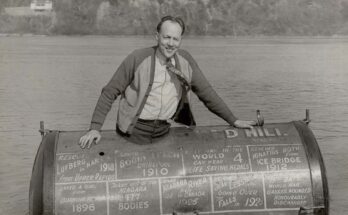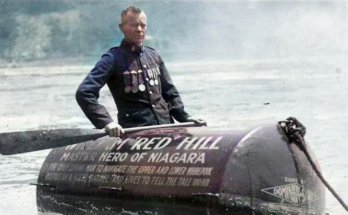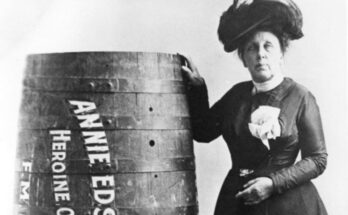Listen here. Full transcript:
The audience held their collective breath as Annie Edson Taylor’s barrel fell over Niagara’s Horseshoe falls and disappeared into the mist. Then nothing, waiting, before Captain Richard Carter on the Maid of the Mist boat spotted the in-tact barrel emerging from the splash pool. He blasted his boat horn for the crowd.
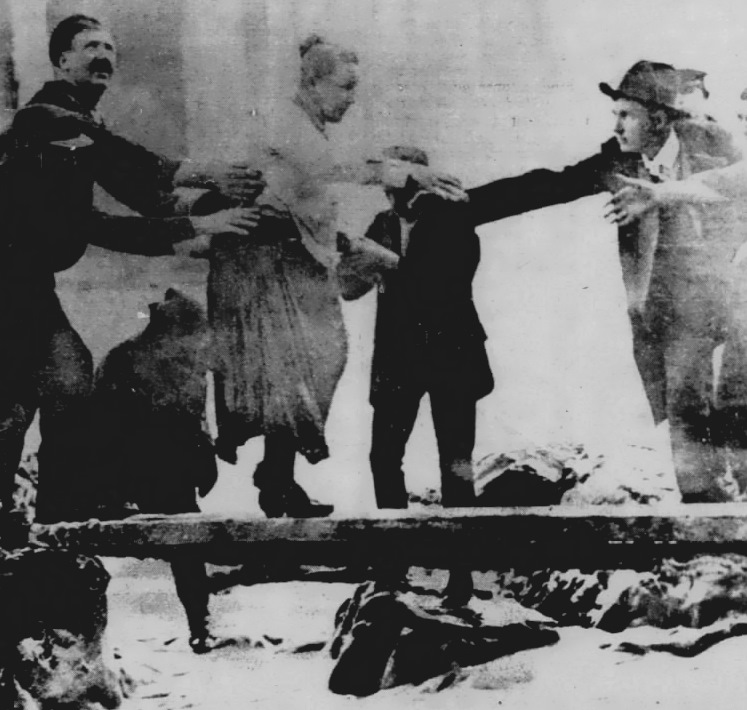
Could it be that she’d done it? Could she still be alive in there? The barrel had kept its shape, but there was no telling how Annie Edson Taylor fared inside. Riverman Fred Truesdale’s experiments with cats and dogs over the falls were a testament to that. The in-tact barrel rode the rapids downstream, and Captain Carter gave chase with his steam powered boat. He had to ease up as it moved into shallow waters and became trapped in an eddy.
A local, Mark Mundi got hold of the barrel by tossing out a grappling hook from shore, and with the help of several others, including Niagara daredevil Carlisle Graham, and boxer Kid Brady, they pulled Taylor to shore and removed the lid of the barrel. Annie Edson Taylor, though dazed and pale, had traveled down Niagara Falls in a barrel and survived.
Intro.
The men gathered on the riverbank did their best to help Taylor out of her barrel, but groggy and shell shocked, she was in no shape to perform the kind of squeezing and wriggling she’d done to get into the barrel at the top of the falls.
They attacked the barrel with a saw and a crowbar, eventually extricated Annie, and helped her to her feet. Her soaked clothes clung to her body, she had a cut on her head, and was pale and shivering. “Thank God I’m alive,” she said, and then later, “Have I gone over the falls yet?” A now-famous picture was taken as she walked over a plank laid over the rocky shoreline, no longer the picture of comportment she’d been when starting her journey. Confused and cold, Taylor said, “I want to go home,” and a carriage took her back to her lodgings. Carlisle Graham, ever the showman himself, made a point of giving a hearty congratulations, though some surmise Graham burned inside that Taylor, a woman, had performed a feat at the falls that he had only lied about doing.
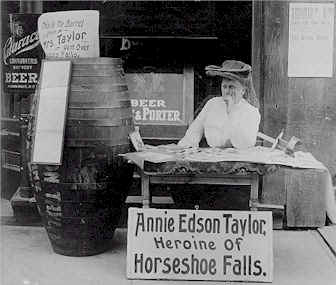
The next day, she gave interviews and talked in a rambling fashion that she would come to regret. Days later, with faculties returned, Taylor would say about that moment, “The bells were ringing, the whistles were blowing; I had accomplished a feat no other person in the world had accomplished.” This of course was absolutely true, and even today, though others have repeated her feat, the simplicity and honesty of her barrel design remain unique. In the 1905 New York State census, Taylor listed her occupation as “heroine,” and she had definitely earned the title.
Whereas leading up to the stunt, she was mocked as a fool, The next day’s newspapers crowned her Queen of the Mist. Coroner Hart Slocum, after weeks of doing his best to prevent the stunt, came to see Taylor and admitted to her that he was the reason the police had been working so hard to stop her, because he’d been certain she would plunge to her death.
Taylor, still very aware of her dire financial situation, told him, “I certainly would have jumped off the bridge or gone over the falls in an attempt to kill myself if I had been prevented. I had very urgent reasons for making the trip over the falls, and if I had failed to make the attempt, I should certainly have committed suicide.”
Poems about the feat appeared in two different papers. Follow up news included humorous anecdotes of marriage proposals. In an interview, manager Frank “Tussie” Russell also made mention of a real love interest in a man with, “…a home and national reputation, she thought she might give the man a tangible inducement for marrying her.” Despite talk of marriage, which certainly was a viable way to attain financial security, Taylor said, “and now that I am in a better condition than ever to care for myself, I assure you that I will toss all such foolish offers to the winds.”
This was to be the beginning of Taylor’s financial success and independence, but things weren’t off to a great start. Manager Frank Russell had the famous barrel towed to the State Park Hotel where souvenir seekers and vandals took out the leather straps, stole the lid, and scribbled on the staves with pencils.
Still, she received her first money-making opportunity selling her story to the New York Journal and Advertiser. Other offers began coming in too, including an offer to exhibit herself and her barrel on the closing day of the Pan-American Exposition in nearby Buffalo, New York.
Print ads read, “Nothing that has happened in the last decade has created more excitement than this feat of a woman of 43 years of age dropping with the waters of Niagara River over the Horseshoe Falls and living to tell the story.” (She was of course 63, just not in the newspapers or in advertisements).
However, Taylor was recovering slowly. Here’s the The Buffalo News account of her appearance at the Pan-American Exposition:
At the foot of the stairs, more rope formed two approaches to the stand. The people passed in one, around the stand where Mrs. Taylor sat, and out the other. There was a continuous stream of humanity, and Sergeant Smith Jackson and his squad of Exposition guards had their hands full keeping the lines straightened out and preventing crushes.
“Mrs. Taylor looks fully the 43 years that she admits. She has the appearance of a woman who has just risen from a sick bed. The cold air seemed to bother her and once or twice she was compelled to leave her receiving stand, to retire behind the big organ in the Temple of Music and get warm by the fires that are always going there.
Several other accounts also report Taylor appearing confused, pale, and slow moving. Taylor reported bouncing on rocks, and may have lost consciousness when inside her barrel, and I think it’s worth listing the Mayo clinics symptoms of concussions here:
- Headache
- Ringing in the ears
- Nausea
- Vomiting
- Fatigue or drowsiness
- Blurry vision
- Confusion or feeling as if in a fog
- Amnesia surrounding the traumatic event
- Dizziness or “seeing stars”
A witness may observe these signs and symptoms in the concussed person:
- Temporary loss of consciousness (though this doesn’t always occur)
- Slurred speech
- Delayed response to questions
- Dazed appearance
- Forgetfulness, such as repeatedly asking the same question
Of course we don’t know exactly what Taylor was feeling or experiencing at this time, we do know that understanding of brain injuries has changed significantly since 1901, and that reports about Taylor’s behavior after her trip down the falls are certainly consistent with that of someone with concussion symptoms. While reports at the time often focus on the superficial wound on her head as she emerged from her barrel at the bottom of the falls, it’s likely she sustained unseen injuries as well.
At the same time, offers were coming in, opportunity finally knocking, but Taylor, fatigued, only wanted to retreat to Bay City to rest. Russell found this nonsensical. They had put everything into this exact money-making opportunity, and as far as he was concerned, it was time to strike while the iron was hot.
Nonetheless, Russell did capitulate and went with Taylor to Michigan. There, she continued to make appearances, and by all reports, looked frail and was sometimes cantankerous and even downright mean, behavior incongruent with her typical demeanor. On November 15, Russell took Taylor to the Oak Grove Sanitorium to recover and as a result, the two of them missed other money-making opportunities.
However, after some rest, she was soon back on the road with Russell. Together they toured Michigan and landed a gig in Cleveland where she sat in a department store window for an hour a day with her cat, supposedly the one that Fred Truesdale had sent down the falls on a trial run, and her barrel. The idea was that Christmas shoppers could stare at her in awe as they moved through the store. Taylor also gave a lecture in the department store basement.
As she continued to tour, the money coming in didn’t keep pace with the expense of travel. Taylor and Russell ran out of money in Cincinnati, and The York County Chronicle reported: “Mrs. Taylor is Broke. Mrs. Annie Edson Taylor, claiming to be the only person who went over Niagara falls, and lived, has made a second appeal to mayor Fleishmann of Cincinnati, to send her home. She was accompanied by her manager, F.M. Russell. Neither has a cent and they owe a board bill at the 8th Street Boarding House. The mayor decided the woman will have to remain in the city and make the bill good, but Russell was given charity transportation to Cleveland.”
This was the moment Annie Edson Taylor lost control of her barrel, her cat, and her plans for retirement. Russell made off with everything, and never contacted her after leaving Cincinnati. She would spend the rest of her life trying to wrestle back a modicum of fame and economic security she and Russell had agreed to seek together.
Taylor eventually made it out of Cincinnati with the help of some sympathetic locals. She made her way to Cleveland, but Russell had already left. She then asked for assistance from the Cleveland relief department, then went on to Lyons New York. Meanwhile, Russell had gone back to Bay City Michigan where he bad-mouthed Taylor to press and stated, “…the people took more interest in the barrel and the cat than they did the woman.”
Penniless, and still in poor health, Taylor continued to pursue Russell, but also took engagements when she could. She began her memoir, “Over the Falls,” which, once published, did sell and offered her some steady income. You can still find it today, and it’s the source, for better or worse, of a lot of information available on Taylor. True in some spots but not in others, it is Taylor’s own words.
Once she did accumulate some money, Taylor sought revenge and hired a team of lawyers to hunt down Russel and her barrel. The legal team found the barrel in Chicago where it was being used to promote an Annie Edson Taylor-themed theatrical show. Taylor hopped a train and told her Chicago lawyer to meet her at the train station and to look for a stout woman dressed in black carrying an alligator skin purse tied with a large, green bow.
Together, Taylor and her lawyer went to the theater where the barrel was being displayed in a window, showed legal papers, took possession of the barrel, and whisked it back to Niagara Falls by train before Russell knew what happened. The Niagara Falls Gazette reported, “She emphatically states that anyone attempting to get the barrel again will carry away with him a chunk of cold lead. She says she has a pistol and knows how to use it.”
Back in Niagara Falls, Taylor secured new representation from William A. Banks, and began a fresh tour only to run into a familiar deceit. During their travels, Banks parted ways with Taylor and took her barrel. To add insult to injury, Banks hired Maggie Kaplan to be a younger, more beautiful version of Taylor. Taylor did her best to track down the barrel, but heard rumors it’d been sold for $500. Eventually, she gave up the chase.
She did however order a facsimile replacement barrel and used it as a prop as she hawk souvenirs to tourists in Lockport, New York including a revised memoir published by a Sanatorium in Buffalo from which Taylor had received medical attention.
In 1911, whiskey-drinking braggart Bobby Leach repeated Taylor’s trip down the falls and had a lot more success making money from the endeavor. Several papers interviewed Taylor about the first man to go down the falls in a barrel, and her responses varied from gracious to bitter.
Perhaps spurred on by Leach’s latest daredevil act, Sterling Camera and Film Company made a silent movie entitled “Over Niagara Falls” and gave Taylor a small part playing herself and reenacting her famous trip. However, like all her other efforts, her film career didn’t amount to much. The film is gone, showing up now as a mention on IMDB and in a Library of Congress list of lost films.
She tried her hand as a novelist too, but failed to find a publisher, and soon she was back streetside hawking souvenirs and talking to anyone interested in hearing her story. Her eyesight began to fail, and perhaps thinking she could flip her ailment into a marketable asset, a sign of clairvoyance, she began offering psychic consultations. An odd conflux of civil war dead, stage magicians, and photography meant spiritualism was having a moment, especially in the Niagara area. When Taylor stopped her readings, her address was taken over by a palm reader.
In 1921, Taylor was admitted to the hospital for treatment related to anemia, and the stay wiped her out of what little money she had.
This is from the March 3rd 1921 Daily Banner (Cambridge, MD): Mrs.AnnieEdson Taylor, heroine of Niagara, first person and the only woman to gov over the falls and live, is in Niagara County infirmary in Lockport. Old, nearly blind, and without friends, she is convinced that fortune does not follow fame, and is prepared to spend her few remaining day – for she is now nearly 75 years old – with the unfortunates in the infirmary.
Of course, she was nearly 83, though tried to tell doctors she was in her fifties.
She died a short time later, and while some papers recounted her life and her extraordinary feat, others, like the Audubon County Journal, took the opportunity to point out her foolishness. “If we were to moralize, it would be on the utter futility of those activities in life that do not result in actual service to others.
Friends took on the cost of burial, and she was laid to rest in the Oakwood cemetery. Her tombstone reads “Annie Edson Taylor. First to go over The Horseshoe Fall in a barrel and live, October 24, 1901.”
There is a legend as to why the tombstone reads fall and not falls, and that is because there wasn’t enough money for the “S”
Around fifty people showed up for her funeral, and while it was happening, over at the falls, Harry Houdini was filming his movie “The Man from Beyond” and sending dummy passengers crashing over the cataract.”
In Oakwood, she is buried near Carlisle Graham, Maude Willard, and other daredevils of her time and after. Some of whom, like Annie Edson Taylor, had to rely on charity for a burial plot and headstone.
There’s no uplifting end to put here, no triumphant portrait or grand monument. Taylor died poor and largely forgotten. Yet her story, her feat, is the defining Niagara Falls story, the one repeated over and over, even if Annie Edson Taylor’s name is not.
A 2011 pamphlet from Oakwood cemetery sums her up by saying “She was haughty and intrepid. Certainly most of what she professed was merely half truths and lies. So, what to do about it? In the end we chose to keep some things as they are and honor the woman who conquered Niagara. Perhaps we did this because we love her and because she reminds us that we are not perfect either.
I like to think Annie Edson Taylor’s story is too complex to mean any one thing. Like any great story, we can all find our own meaning in it.
However, I can’t close this out without adding in one more news item I couldn’t find a space for elsewhere, one about the commonality of fear. It comes from the Feb. 6 1903 Niagara Falls Gazette:
Not ALWAYS BRAVE,
The other day Mrs. Annie Edson Taylor, the woman who had the courage to go over the fale In a barrel, went tremblingly into the local dentist’s office and stated that she wanted a tooth extracted. After announcing her errand, she sat in a chair and went through the preliminary stages of a faint. “I was never so nervous in my life as I am at this moment,” said Ms. Taylor. “I have a horror of a dentist’s chair.” After some talk the dentist learned of the woman’s identity and remarked that a woman who had the courage to make the trip she did should not fear a dentist. “I had no fear whatever when I made the trip,” said Mrs. Taylor, “and was good as could be, but I can hardly control myself now.” It would be interesting to see how Mrs. Taylor would act in the presence of an unwanted mouse.
Maybe one more lesson we can take away is that brave or cowardly, prince or pauper, Queen of the Mist or common folk, we should all go to the dentist.

